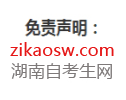以下是湖南自考生网为考生们整理的“2006年4月自考00096外刊经贸知识选读真题及答案”,考生可通过自考历年真题练习更有把握的面对考试,对题型更加熟悉,从而取得更佳的成绩。供考生参考。
2006年4月高等教育自学考试
外刊经贸知识选读试题
课程代码:00096
I. Choose one answer that best explains the underlined part of the following statements or best completes them:(30%)
1.Farmers bartered rice for machinery.
A. exported B. imported
C. exchanged D. charged
2. Money is still a major incentive in most occupations.
A. procedure B. stimulus
C. potential D. section
3. For China’s newly-rising enterprises, profits are up throughout the region — thanks largely to low wages.
A. products B. sales
C. bonuses D. returns
4. The workers demanded the same wage and the same treatment! There must be no discrimination.
A. distribution B. prejudice
C. agreement D. performance
5. Victims of the world’s largest industrial accident got $470 million compensation.
A. conversation B. payment
C. preparation D. competition
6. South Korea needs only some degree of sweat and some degree of technological sophistication.
A. effort B. water
C. fever D. sweet
7. Experts predict that the stock market will remain buoyant.
A. buying B. rising
C. declining D. descending
8. International conditions for growth in developing countries deteriorated in 1991.
A. bettered B. determined
C. worsened D. damaged
9. Far from capitulating to this new thrust of American trade policy, Japan is taking a stand that could lead to a trans-Pacific confrontation.
A. point B. pressure
C. pull D. priority
10. Measures to reduce costs are beginning to take effect.
A. affect all sides B. produce desired results
C. impact cost D. have influence
11. A business tax cut is needed to spur industrial investment.
A. spread B. spoil
C. stimulate D. spill
12. I wanted to go out, but I had no money. I had no alternative but to stay at home.
A. alternate B. choose
C. alert D. choice
13. A key element of his economic program is the promotion of free trade and investment.
A. encouragement B. protection
C. excitement D. innovation
14. Speculators deserted the security and big yields afforded by the equity and money markets.
A. stock B. asset
C. equality D. sales
15. Trade and investment liberalization will aggravate the competition on the domestic and international markets.
A. world B. foreign
C. local D. abroad
II. Translate the following phrases into Chinese: (10%)
16.most-favored nation treatment
17.trade surplus
18.hard currency
19.merger of banks
20.liquid assets
21.a hermit nation
22.trade negotiation
23.at a rough estimate
24.Chinese Export Commodities Fair
25.foreign exchange reserves
III. Translate the following phrases into English:(10%)
26.独家经销合同
27.经常项目
28.清算协议
29.人均收入
30.无壁垒市场
31.双重税
32.房地产
33.试销
34.知识产权
35.商业周期
IV. Read the following passages and answer the following questions in English:(18%)
Passage 1
A clearly confident China has rolled up a large section of its bamboo curtain, declared itself “open to the outside world” and hung signs on nearly all its cities inviting foreign investors to come and do serious business.
For foreign investors, the prospect of having access to a market of 1.3 billion consumers no longer seems like a pipedream. The Chinese-in particular the rural population-are getting richer and now want visible improvements to their standard of living: they aspire to own colour TV sets, refrigerators, trucks, washing machines and better radios, bicycles and clothing. Even local factories are taking note of the vast potential sales in their own domestic market.
36. Please paraphrase “has rolled up a large section of its bamboo curtain” in Line 1.
37. What is implied by using the word “better”? Does it refer merely to the quality of goods here or something more?
38. What do “having access to” and “sales” mean?
Passage 2
America wants Japan to meet import targets for some American goods. An unwilling Japan has decided to draw the line.
Once, when Japan faced pressure from abroad, it would either give in reluctantly or keep quiet and hope that the fuss would die down. No longer, it seems. The Clinton administration strongly believes in exerting such pressure. Its policy is to open some Japanese markets (which it deems to be closed) by setting import targets-an approach to trade policy that supporters call “result-oriented”. This ugly term foreshadows uncertain consequences. Far from capitulating to this new thrust of American trade policy, Japan is taking a stand that could lead to a trans-Pacific confrontation.
39. Please give a synonym to the expression “give in” and explain the meaning of “draw the line”.
40. What would Japan do in the past when foreign countries put pressure on its international trade policy?
41. Please paraphrase the underlined sentence “No longer, it seems”.
V. Read the following two passages and decide whether the statements are true or false. Mark T for true and F for false in the brackets given: (20%)
Passage 1
China is now reaching for the next rung on the economic ladder. Last fall Beijing agreed to open its markets to more U.S. goods, including everything from Polaroid film to automobiles. In return, Washington would support China’s membership in the General Agreement on Tariffs and Trade. Membership in this club, which includes all the world’s leading economies, could provide a huge boost for a low-wage export economy. Already though, China’s commercial strength is starting to worry competitors. Last year China’s trade surplus surged, buoyed by exports of toys, textiles and consumer electronics. Its trade surplus with the United States hit a record $18 billion. Only Japan’s was larger. With the U.S. Congress due to consider the renewal of China’s most -favored nation trade status in June, officials in Beijing fear the trade imbalance could surpass human rights as a source of U.S. opposition to preferred status for China. “The trade surplus itself will be the No.1 problem this year,” says one Chinese official. “After Japan, we’ll be first in line for retaliation.”
Statements:
42. China’s trade surplus, mainly from exports of toys, textiles and consumer electronics, decreased last year.
43. The strategy of opening markets to more U.S. goods is adopted by Chinese leaders in the hope of obtaining Washington’s support in winning back China’s membership in GATT.
44. China became the country which held the largest trade surplus with the U.S. last year.
45. In the past, the trade imbalance was regarded as the more important source of U.S. opposition to preferred status for China than human rights.
46. Officials in Beijing attach much importance to the trade surplus.
Passage 2
Nike is the world’s largest supplier of athletic footwear and among the most successful consumer-products companies to have emerged in the past 20 years. Part of that success has come about by paying rock-bottom wages to the workers who make the shoes. All but 1% of the 90 million shoes Nike makes each year are manufactured in Asia.
Nike is as American as Coca-cola. Part of its appeal to the millions of people around the world who buy its athletic shoes is that Nike is selling a sense of freedom. “Just do it!” exult Nike’s advertisements.
But there is a rough side to this dream: the ruthlessness with which Nike pares its costs. The company is for ever on the look-out for cheap production sites. If costs in a particular country or factory move too far out of line, productivity will have to rise to compensate, or Nike will take its business elsewhere. The firm uses about 40 factories; 20 have closed in the past five years or so and another 35 have opened.
Nike may look like an all-American enterprise, but its success relies on its ability to harness Asia’s spectacular manufacturing expertise. “We’re always looking for new manufacturing sources,” says Nike’s vice-president for production. “People ask why we don’t produce more in Eastern Europe, but we’ve concluded that the most capable manufacturers are in Asia.”
The organization of Nike is simple and effective. All the production risk is taken by contractors. “We don’t know the first thing about manufacturing,” says Nike’s vice-president for Asia-Pacific. “We are marketers and designers.” There are the areas on which it concentrates its resources. Yet it retains the advantages of firms which produce in-house, namely a high degree of control over quality and the ability to respond rapidly to changing tastes.
Until recently, almost all Nike’s shoes were made in South Korea and Taiwan, but as labor costs there have soared, the firm’s contractors in these two areas have moved much of their production to cheaper sites in Indonesia and Thailand.
Statements:
47. The most important ingredient of Nike’s success is giving people a sense of freedom.
48. The quantity of shoes Nike manufactures in Asia each year is about 90 million.
49. As all the production risk is taken by contractors, Nike’s main concentration is on marketing and designing.
50.Nike prefers to produce in Asia rather than in Eastern Europe because they think the Asian market is bigger than Eastern Europe’s.
51. To keep costs low, Nike’s most important strategy is to produce in countries where labor costs are still low.
VI. Translate the following passage into Chinese: (12%)
52.In matters relating to the environment, the United Nations Conference on Environment and Development, held in June 1992, produced an “Earth Charter,” or declaration of basic principles for the conduct of nations and peoples with respect to environment and development; agreements on specific legal measures, including conventions on climate change and biodiversity, and principles for a framework agreement on forests; and an agenda for action.
以上“2006年4月自考00096外刊经贸知识选读真题及答案”由湖南自考网指导老师收集整理。
TEL:蒋老师17773102705
扫一扫下方二维码关注湖南自考生网微信公众号、客服咨询号,即时获取湖南自考、成考、网教最新考试资讯。

关注公众号免费拿资料

微信扫一扫咨询

微信扫一扫咨询

1、鉴于各方面资讯时常调整与变化,本网所提供的信息仅供参考,实际以考试院通知文件为准。
2、本网部分内容来源于网络,如有内容、版权等问题请与本网联系,我们将会及时处理。联系方式 :QQ(393848300)
3、如转载湖南自考生网声明为“原创”的内容,请注明出处及网址链接,违者必究!